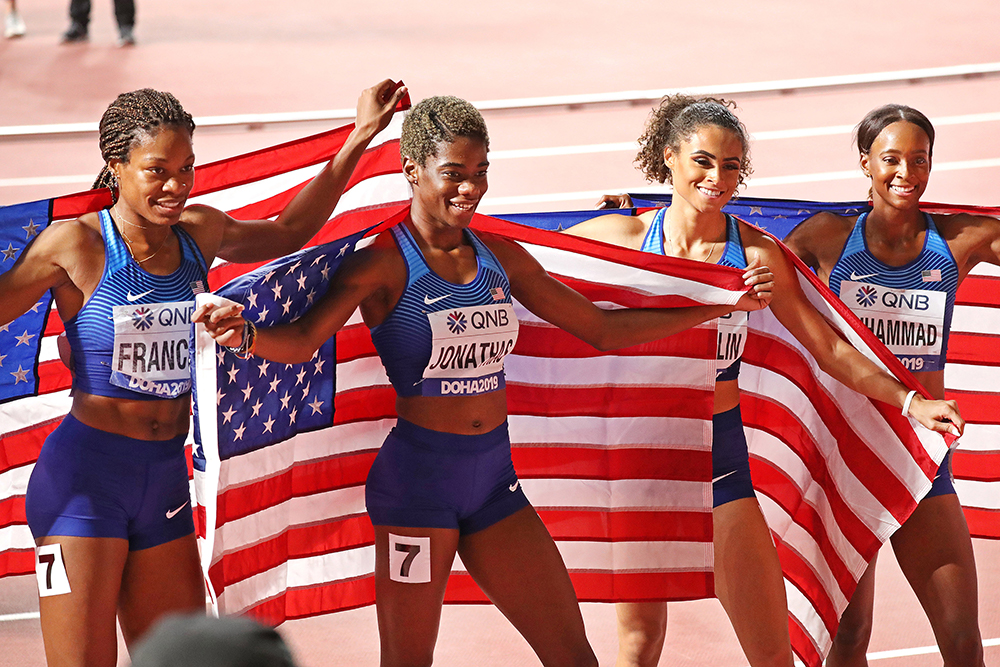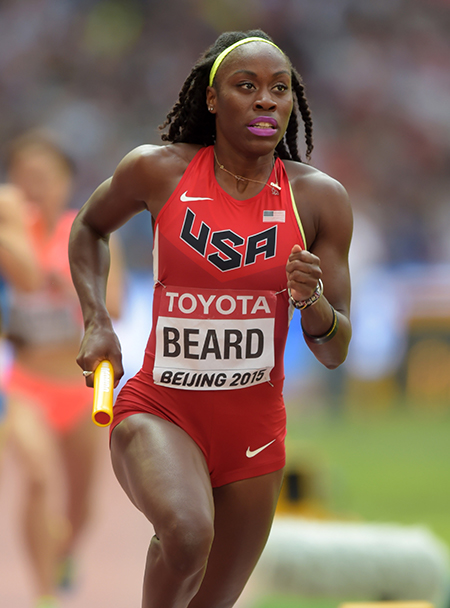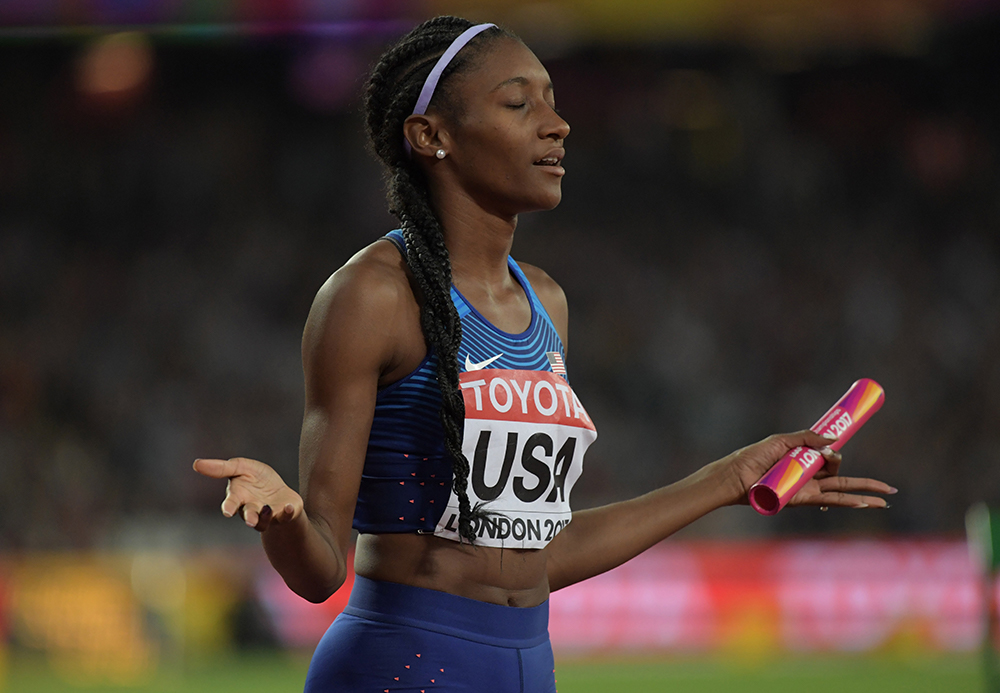
THE QUARTER. The 1-lapper. The 400. By any name, it is the most brutal of the sprints, asking of its practitioners the ability to flat out sprint like a maniac and then to find some magical way to hold on while the lungs and legs and every freaking cell in their bodies screams for them to “STOP!”… and yet somehow they keep going past the line.
Sometimes they nearly don’t make it—recall Bahamian Shaunae Miller-Uibo all but blacking out in her final strides in Rio, falling across the line just barely ahead of Allyson Felix.
In a Tokyo ’21 scenario, there probably won’t be a Miller-Uibo in the event. The reigning champion says she will likely opt for the 200 if forced to choose. The schedule says she will be forced to choose and the IOC says it’s not inclined to change it so SMU can have her Michael Johnson/Marie-Josée Pérec experience. And reigning world champion Salwa Eid Naser is looking even more unlikely, now that she is provisionally suspended for 4 whereabouts failures.
The absentees won’t matter much to U.S. fans, who will be focused on an especially generous and dazzling mix of veterans and up-and-coming talent. Here’s how the lineup looks from a year—a very strange year—away, starting with the 6 headliners for whom we did separate stories:
Phyllis Francis is the ’17 world champion and the No. 1 American for each of the last three seasons. At 28, she has plenty of experience at a high level, from 5th in the last Olympic final to her WC gold in ’17. The Oregon grad hit a PR 49.61 in the World final last fall in Doha and is working hard to get back on top.
Wadeline Jonathas, just 22 now, beat Francis in Doha with a PR of her own, 49.60. That capped a season of startling improvement, as she entered it with a best of just 52.86, having recently moved up from NCAA Div. III to Div. I’s South Carolina. She started ’20 in fine form, winning the USATF title in Albuquerque.
At 34, Allyson Felix is the veteran of the event. She says she has not decided yet on the 200 or the 400. The shorter race is where she won her Olympic gold in ’12. She made her first foray into the 400 at a championship meet in Daegu in ’11—where she won bronze at 200 and silver at 400. From 2015-on, though, she has made the 400 her event of choice in international competition.
Shakima Wimbley, 25, has gone back to her college coach and reinvented herself after her debacle in Doha. The talent that made her the national champion in ’18 with a stunning 49.52 is still there.
Kendall Ellis, the former USC superstar, feels like her first year as a pro was a struggle, but she says she is more than ready for round 2. Now 24, the American Indoor record-holder (50.34) sports an outdoor best of 49.99.
Courtney Okolo, 26, ran on the 4×4 gold medal squad in Rio. That was the year she produced her career best of 49.71. Last year she just missed the individual squad for Doha with her USATF 4th.
Others To Watch

Jessica Beard is still in the game at 31, training in the Austin area. She ran on World Champs gold medal relays in ’09, ’11 and ’13. Yet she still improved long after those years, hitting a PR 50.08 behind Wimbley at the ’18 USATF. Last year she finished 5th at nationals.
Another pair of significant 30-somethings who haven’t yet officially hung it up: 34-year-old Natasha Hastings and 31-year-old Francena McCorory, each of whom has a pair of Olympic 4×4 golds in her treasure chest.
Quanera Hayes ran her best of 49.72 in ’17, winning the national title. She made it to the semis in London and earned gold on the relay. Her ’18 campaign ended early and that fall she had a baby boy. Now she’s back, placing 3rd at the USATF Indoor this winter. A late bloomer, Hayes, now 28, ran collegiately for Div. II Livingstone. But if two consecutive sub-50 years is an indication of her talent, she will be a contender post-childbirth.
Lynna Irby, 21, made herself the talk of the event when she won the NCAA title in ’18 as a Georgia frosh, clocking a jaw-dropping 49.80. She turned pro after that and had a rough ride in year 1, failing to make the finals in the USATF 400 (though she placed 6th in the 200). She showed good form in her only meet this season, hitting 23.06 into a headwind behind Miller-Uibo in a Florida meet in early July. If that means she’s finding her feet as a pro, she is another good prospect for the Olympic team.
Jaide Stepter, 25, has in the past split her time between the 400 flat and hurdles. In ’16, she ran her hurdle best of 54.95 in finishing 7th at the Trials. In ’18, she left the hurdles behind and saw an improvement in her flat time to 50.63. For the USC alum, now training with coach (and former hurdle great) LaTanya Sheffield, the calculus of choosing the flat over the hurdles for ’21 seems clear.
In the 400H, there are three spots available, and the U.S. already has the top two athletes in world history. Stepter gets it, saying her chances are better on the flat: “I’ve had a lot of success in [the 400] and see a great opportunity to make the team in an individual race as well as the relay pool.”
Ashley Spencer has to be mentioned here, by virtue of a 50.28 PR from way back in ’13, the year she won World gold as part of the U.S. 4×4. Obviously, she is primarily a 400 hurdler, having won Rio bronze in ’16. Since then she has focused exclusively on the barriers to the tune of four straight World Rankings. But yes, she has options.
Kendall Baisden, now 25, was the World Junior champ in ’14 as a Texas frosh and NCAA runner-up the next season. After two years with the Longhorns she moved to LA and split her time between modeling and running. Now she’s back in Austin, training alongside Spencer and Okolo. Her PR of 50.46 came when she was 19; it may be due for a revision now that she is training full-time again.
The Kids Might Be More Than Alright
Most years, it’s asking a lot to expect that the top NCAA stars make the leap to be competitive with the pros in the 400. However, the Olympic delay combined with the cancellation of the NCAA outdoor season has given the young ones an extra year to build strength. Surely many may lose a step in their development by missing a year of competition. However, you can bet on a few surprises to emerge.
Chloe Abbott was the NCAA runner-up in a PR 50.98 last year, after transferring to Kentucky to follow coach Lonnie Greene from Purdue. She has improved significantly each year and still has one outdoor NCAA season left. She’ll be in the mix, says Greene: “She’s that good.”
Arkansas’s Kethlin Campbell had a banner first year in the 400 for the Razorbacks, placing 4th at the NCAA in 51.09 after earlier winning the SEC crown in a PR 51.03. A transfer from Duke, she had previously been a 100/200 type, where she has bests of 11.56/22.90. With two years of eligibility remaining at Arkansas, Campbell works with assistant Chris Johnson and could expect to see more improvement as she gets more familiar with the 1-lapper.

Syaira Richardson spent her first collegiate year at Ohio State before transferring to Texas A&M. There, she developed into a national force, placing 2nd at SECs to Campbell in a PR 51.17. She finished 7th at the NCAA meet and anchored the winning 4×4 in 50.83. Now 21, Richardson still has plenty of room to grow.
A promising 51.21 prep—and NBN champion—Alexis Holmes is finding her feet again after transferring to Kentucky. Last year she was the Big 10 champ for Penn State, then over the summer captured Pan-Am Junior silver. This winter she won the SEC Indoor at 52.08. The 20-year-old still has three outdoor seasons remaining with the Wildcats.
Kaelin Roberts of USC won the ’29 NCAA Indoor in 51.50. She PRed at 51.25 to win the Pac-12 title but injury kept her out of the NCAA meet outdoors. Now 21, she has two more seasons with the Trojans and looks to be in the mix—provided she can stay healthy.
And for a real young possibility, how about Kayla Davis, all of 16 years old? The North Carolina prep won the New Balance title last year in a PR 51.17, and followed up with wins at the USATF and Pan-Am Juniors—all as a 9th-grader. Not since sisters Sherri and Denean Howard made the ’80 Olympic team has a prep qualified in the 400. Davis doesn’t lack for confidence: “I can run whatever I want to run; I just have to put my mind to it.”
And The Relays?
No discussion of the 400 is complete without a consideration of the relays (Tokyo will see the traditional 4×4 joined by the Olympic debut of the mixed-sex 4×4). And no discussion of the baton scene is complete without mentioning two crucial names: the world’s top two 400 hurdlers.
Dalilah Muhammad, 30, is an untapped talent at the flat 400. Her best is a 50.60 from a small meet in Poland last year. Over hurdles, she is without peer, as the reigning world and Olympic champion and World Record holder. Those credentials are good enough that U.S. coaches didn’t hesitate to add her to the 4 x 400 in Doha, where she split 49.43 on the third leg.
Sydney McLaughlin is one of the sport’s most heralded wunderkinds. She turns 21 in August and is already the No. 2 hurdler in world history with her 52.23. Her flat 400 best is 50.07 from early ’18. In the 4×4 finals in Doha, she ran 48.8 unpressed on the second leg.
Jonathas anchored the 3:18.82 Doha performance with a 50.20, running alone the entire way. And that underscores the U.S. women’s long relay situation. It’s an almost certain pair of golds on days where everything goes as expected. The last 6 Olympic 4x4s have been punctuated with The Star-Spangled Banner. At the WC level the record is nearly as good, with 8 golds and 5 silvers since the meet’s ’83 debut.
All of which means that a spot on the U.S. is a nice gig, and even better if you get to run in the finals. Being able to put “gold medalist” on your resume can open doors and generate better paydays for a struggling professional athlete.
In Doha, Ellis and Felix ran in the heats. However, with Muhammad and McLaughlin coming in for the finals, Ellis had to watch the ultimate race—and the podium presentation—from the stands. “I have mixed feelings about it just because I think it’s difficult not to take it personally. This is your career and this is what you love. You almost feel obligated to a spot on the team. But especially as a quartermiler, you have to take your own feelings out of it and look at it from the perspective of, OK, who got into the 400-meter final? If they got into the final, then hands-down they deserve a spot on that relay. They earned it.
“You have to look at it as, ‘Did you earn a spot?’ You’re not entitled to a position just because you made the team. You’re not entitled to a spot there just because of things you’ve done in the past. You have to earn your spot through every round and every single race. It’s hard to accept that sometimes because you feel like, ‘OK, I proved myself by making the team, is that not enough?’
“And it’s not. Because the 400 field is so deep with American women right now, you can put any four women on that team and we will come out with gold. That’s just—it is what it is. That’s how deep and talented the field is now. The mindset can’t be, ‘I want to run on this relay.’ The relay’s the fun part. I’ve started looking at it now as, do what you’re supposed to do in the open events, and then you’ll get rewarded with the relay.”
Another who will be in the discussion is the holder of America’s fastest split ever, 47.72 (at Beijing in ’15). That would be Felix. Whether she qualifies in the 200 or the 400—or neither—she still could possibly end up on a relay squad. For starters, she’s always been reliable with a stick. Add to that the idea that the U.S. coaches might see it as good for the sport to give her a chance to break the women’s record for the most Olympic medals ever.
Says Felix, “It’s kind of a position that I’ve always had that I’m, you know, if they can use me [on the relay] then that’s amazing.”
Wimbley knows the thrill—and the heartache—of the relay. In ’17, she ran third leg in final of the 4×4, and stood on the podium with Felix, Francis, and Hayes. “It’s unexplainable, you know?” she says of her London experience. “It was just like, ‘Wow, I’m taking the stick from Allyson at the World Championships. I’m in the final of the 4×4, 60,000 people in the stands.’ I was elated. I felt powerful and I was happy. This is what I want, you know? I just love—I just love it, you know?”
They all do. Which is why the Trials 400 will be one of the must-see events of the ’21 season.